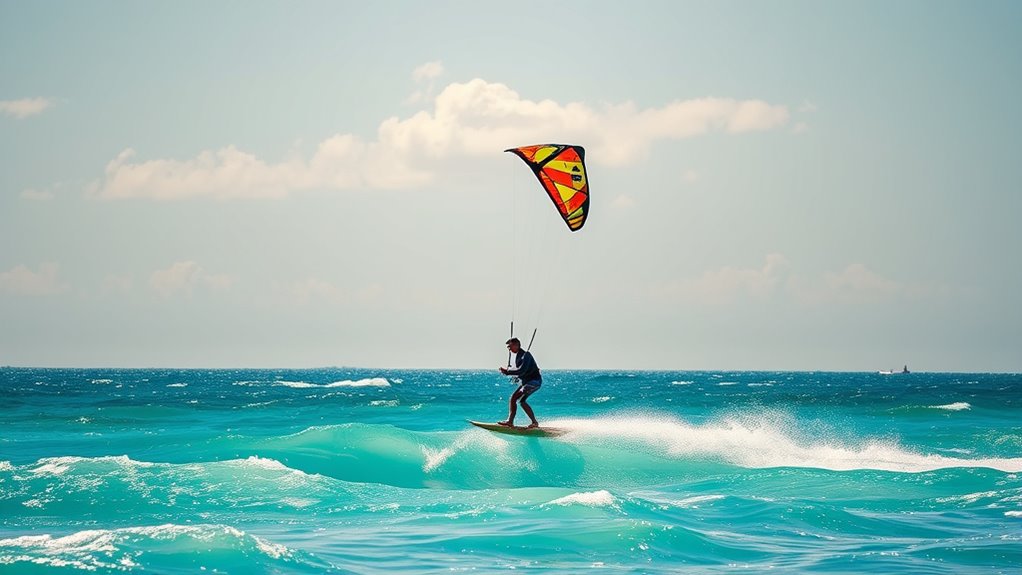Understanding the wind window helps you choose the best wind directions and speeds for kitesurfing. The wind window has specific zones, including power zones near the center, where the kite is most responsive and provides ideal speed and control. Staying within these zones ensures safety and better performance. Recognizing how to navigate and use the power zones effectively can boost your confidence on the water—and there’s more to learn about mastering these zones for safer, smoother rides.
Key Takeaways
- Wind windows are specific directions and speeds ideal for safe, effective kitesurfing, especially within power zones for optimal lift.
- Power zones are located near the center or slightly off-center of the wind window, where wind strength is steady and strong.
- Recognizing power zones involves observing kite responsiveness and rider speed to maximize control and performance.
- Navigating power zones requires smooth kite control, slight forward positioning for maximum pull, and gradual depowering for safety.
- Proper safety practices, including gear and awareness of wind conditions, are essential when riding within power zones.
What Are Wind Windows and How Do They Affect Kitesurfing?
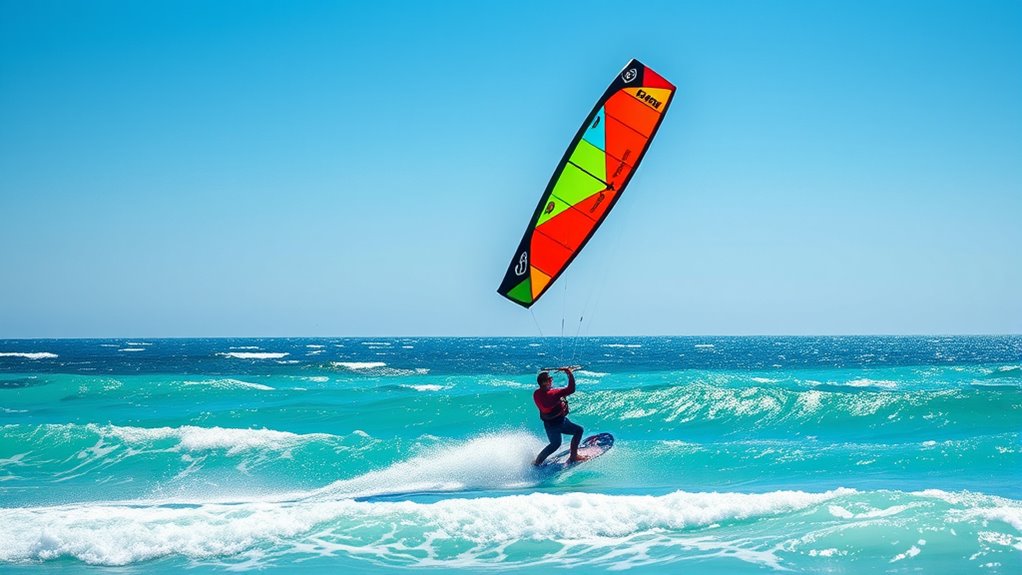
Wind windows are the specific directions and speeds of wind that are ideal for kitesurfing. They determine when and where you can ride effectively. When wind blows within this window, you’ll experience peak lift and control, making your session smoother and more enjoyable. If the wind is too weak, your kite won’t generate enough power, and you’ll struggle to stay up. Conversely, if it’s too strong or gusty outside the window, safety becomes a concern, and riding can become dangerous. Understanding your wind window helps you choose the right times and locations for kitesurfing. It guarantees you stay within safe limits while maximizing performance, giving you confidence to push your skills without risking accidents.
The Structure of Wind Windows: Zones and Their Characteristics
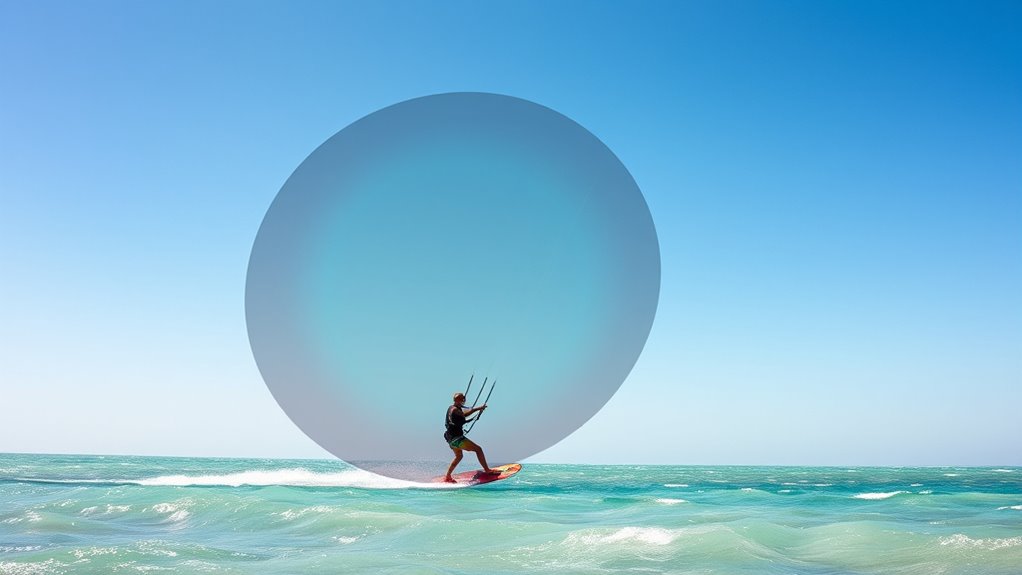
The structure of a wind window is divided into distinct zones, each with unique characteristics that influence your kitesurfing experience. These zones shape how your kite feels and behaves, helping you choose the right position for your skill level and conditions. Imagine standing in the center, with the wind window spreading out around you. As you move closer to the edge, the wind weakens, and your kite becomes less responsive. Understanding the wind window zones can help you optimize your control and safety while riding. Recognizing the power zones within the wind window is essential for managing your kite’s lift and pull, especially during jumps and tricks. Additionally, different skin sensitivities can affect how comfortable you are when performing maneuvers near the edges of the wind window. Being aware of wind strength variations across these zones can also assist in adjusting your technique for different conditions. Furthermore, understanding caffeine content in espresso can metaphorically help you stay alert and focused during challenging maneuvers.
Identifying and Utilizing Power Zones for Optimal Performance
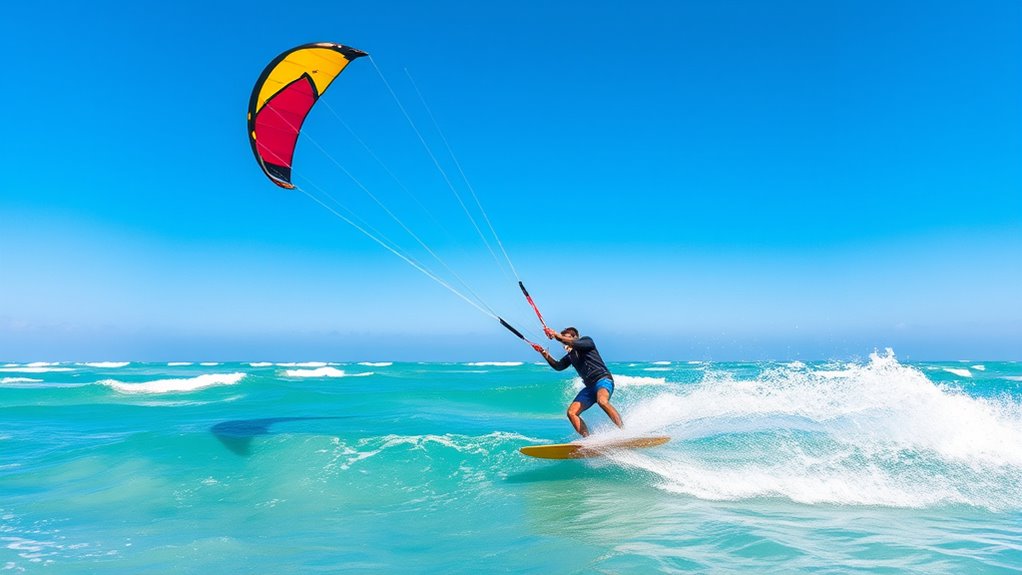
To maximize your kitesurfing performance, focus on identifying and harnessing the power zones within the wind window. These zones provide the most consistent and strong winds, essential for speed and control. Look for areas where the wind feels steadier and more forceful, typically near the center or slightly off-center of the window. Use visual cues like the kite’s responsiveness and your speed to gauge power. Understanding these zones helps you plan your runs and conserve energy. For optimal results, it’s important to recognize the different wind conditions and how they affect your ride. Being aware of how sound waves influence wind patterns can also enhance your ability to predict and utilize these power zones. Incorporating knowledge of atmospheric conditions can further refine your understanding of wind behavior. Additionally, paying attention to wind shear can improve your ability to stay within the most advantageous zones during your session. Recognizing the impact of pressure gradients on wind consistency is also crucial for strategic positioning. Here’s a quick visual guide:
| Zone | Characteristics | Best Use |
|---|---|---|
| Power Zone 1 | Strong, steady wind, central position | Boost jumps, accelerate |
| Power Zone 2 | Slightly off-center, still strong | Maintain speed, control |
| Lull Zone | Weaker, inconsistent wind | Avoid or reposition |
Techniques for Navigating and Staying Within the Power Zone
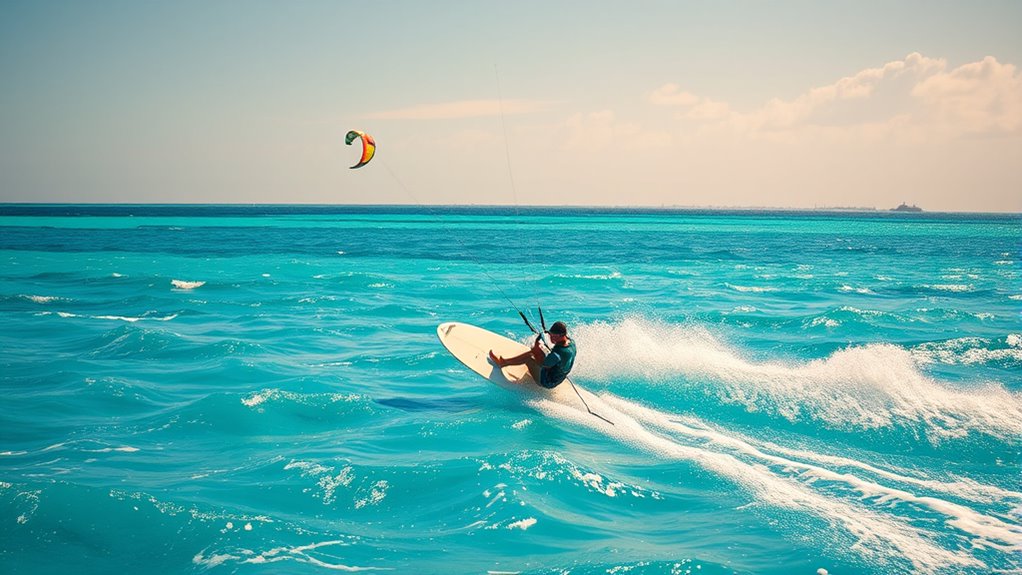
Mastering how to navigate and stay within the power zone requires precise control and awareness of your kite’s position relative to the wind window. To do this effectively, you need to keep your kite moving smoothly through key points:
- Keep the kite slightly forward in the window during your pull for maximum power.
- Shift the kite back to depower when you want to reduce pull or prepare for landing.
- Use small, controlled movements to maintain steady pressure without overcorrecting.
- Constantly watch your kite’s position, adjusting your body and lines to stay centered in the power zone.
- Understanding Volkswagen Tuning concepts can also help you better understand how to optimize your kite’s position and power delivery for more effective control.
- Developing a good sense of wind window awareness enables you to anticipate changes and adjust your technique proactively.
Safety Tips and Best Practices for Managing Power Zones

Since managing the power zone can quickly become dangerous if not handled properly, prioritizing safety is essential. Always wear appropriate safety gear, including a helmet, impact vest, and a harness with quick-release features. Before entering the water, check your equipment thoroughly and understand the wind conditions. Stay aware of your surroundings, keeping a safe distance from other kitesurfers, obstacles, and swimmers. Practice controlled, gradual power application to avoid sudden surges. Keep a clear communication plan with your spotter or team, especially during jumps or tricky maneuvers. If you feel overwhelmed or unsure, depower your kite and steer to a safe area. Regularly review safety protocols and stay within your skill level to minimize risks and enjoy a safer kitesurfing experience. Understanding your power zones and how they operate is crucial for effective control and safety. Being familiar with wind windows helps in predicting how the kite will behave in different zones, reducing the chance of accidents. Additionally, staying informed about local weather conditions can significantly improve your safety and control while kitesurfing. Proper knowledge of glycolic acid benefits for skin can also prevent skin issues caused by exposure to harsh elements during outdoor sports, ensuring your skin remains healthy and protected. Moreover, understanding the role of credit card insights in personal finance management underscores the importance of proper planning and safety measures in all aspects of your activities.
Frequently Asked Questions
How Do Weather Changes Influence Wind Window Dynamics During a Session?
Weather changes can substantially impact your wind window during a kitesurfing session. As conditions shift, wind speed and direction may fluctuate, narrowing or expanding your power zones. You might notice stronger gusts or lulls, which require quick adjustments to your kite’s position. Staying alert to weather updates helps you anticipate these changes, ensuring you stay within safe, ideal wind zones and maintain control throughout your session.
Can Wind Windows Vary Significantly Between Different Kite Models?
Your wind window experience can be as unpredictable as a tornado, especially when switching between different kite models. Yes, they can vary markedly because each kite’s shape, size, and design influence how it catches and responds to the wind. Larger or more aerodynamic kites might generate more power in certain zones, while smaller or specialized kites might perform differently. Always check your kite’s specifications to understand its unique wind window behavior.
What Role Does Rider Skill Level Play in Managing Power Zones Effectively?
Your skill level greatly impacts how well you manage power zones. As a beginner, you might struggle to control the kite in strong wind areas, risking accidents. With experience, you learn to anticipate kite behavior and adjust your stance and input to stay within safe power zones. Advanced riders skillfully harness these zones for maximum performance, smoothly shifting between power and de-powering, ensuring safety and efficiency in various wind conditions.
Are There Specific Geographic Features That Alter Wind Window Patterns?
You’ll find that geographic features like mountains, cliffs, and bodies of water can considerably change wind window patterns. These features channel, block, or accelerate wind, creating unpredictable or stronger gusts. As a kitesurfer, you should observe how local terrain affects wind behavior, so you can adjust your launch spots and timing. Recognizing these patterns helps you stay safe and maximize your enjoyment on the water.
How Does Equipment Setup Impact a Rider’S Ability to Stay Within the Power Zone?
Your equipment setup is vital—it’s like the secret weapon to mastering the power zone. If your lines are too long or too short, or your harness isn’t snug, you’ll struggle to stay in the ideal wind area. Properly tuned gear helps you respond quickly and stay within the power zone, giving you the control and boost you need. Adjust your setup carefully, and you’ll reveal the full potential of every gust.
Conclusion
Mastering the wind window is like riding a wave—stay within the power zone, and you’ll ride smoothly and confidently. By understanding its structure and how to navigate it, you’ll harness the wind’s energy securely and efficiently. Remember, staying alert and respecting the zones keeps you in control and ensures every session is a thrilling, yet safe adventure. Keep practicing, and soon you’ll glide through the wind window with the skill of a seasoned kite surfer.

